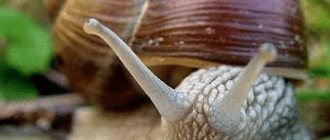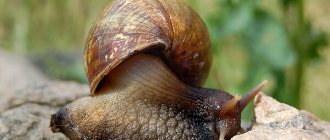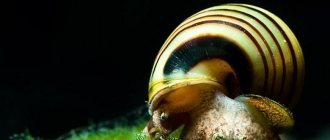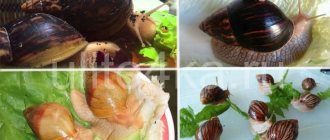The grape snail belongs to the phylum of mollusks, the class of gastropods, the family of terrestrial stalk-eyed pulmonary snails.
This species is considered the largest in all of Europe, the central and southeastern part of which is the place of origin and habitat of these mollusks. For a long time, the grape snail has been consumed by humans as food, but it has never been considered a delicacy, and therefore was available to people of any social status.
The period of activity of the animal occurs at the beginning of spring and until the first autumn cold weather. The rest of the time the snail is in a state of suspended animation. The lifespan of a mollusk in natural conditions is 7-8 years (in some cases it can reach 20 years). According to official data, the maximum age of a grape snail kept at home was 30 years.
Description
Grape snail belongs to the class of pulmonary snails of the Helicid family, which unites more than 300 species. This is one of the largest European gastropods.
The maximum leg length of an adult is from 3 to 6 cm, and if the mollusk stretches out, its body is up to 10 cm.
With the help of a large and muscular foot-foot, snails move by contracting muscles and pushing off the surface. Secreted from glands located in front of the body, mucus reduces friction and facilitates movement. Individuals move at an average speed of about 2-3 mm per second. With the sole they can easily stick to horizontal and vertical surfaces.
The diameter of the outer shell is on average about 5 cm, it is yellowish-brown in color, often with light stripes in the upper part. The body under the shell is elastic and soft, covered with wrinkles, the role of which is in the accumulation of fluid in the body.
On the head there is a mouth opening and two pairs of tentacles, the lower one is responsible for the sense of smell, it is shorter. On the top are modified eyes that are insensitive to the color spectrum. They react only to the brightness of the light, and can distinguish objects no further than 1 cm. In the folds of the mantle on the body there is a breathing hole; this is a pulmonary organism.
In nature, the average lifespan of a grape snail rarely exceeds 10 years, although its lifespan in a terrarium is much longer - up to 30 years.
Mollusks prefer daytime sleep and active night wakefulness.
During the cold season, grape snails hibernate, sometimes for up to six months, and the shell opening is closed with a special cork substance made of lime - epiphragm. The sole of the foot is attached to the soil, and the body is curled up under the shell.
In artificial detention, suspended animation is also necessary, short-term or long-term; it is easiest to cause it under stress from violation of the conditions of detention.
Most often, it is not individual individuals who hibernate, but entire colonies of snails, choosing a quiet place under stones, leaves, or burrowing up to 40 cm into the soil. In the spring they wake up en masse, having lost about 10% of their weight over the winter.
How to reproduce
The necessary conditions
To grow cephalopods, you can prepare special containers with soil. The snail will lay its eggs in it. Then the found masonry is moved into a container with soil, it will serve as an incubator. The lid of the container should be sprayed with water from time to time. The most important things for egg development are warmth, humidity and darkness. The lid must be closed; the eggs do not need air. It will take less than a month to wait for offspring. At an optimal temperature of 20 to 30 degrees, babies are born at the same time.
Care of offspring
Important! Hatched babies need to be placed in a separate enclosure on time. Newborns should not be placed with adults, because the young can be eaten. If it is not possible to search for clutches in the ground, young individuals are collected on the surface before they crawl away. In a separate enclosure, the kids grow up, receive food, do not have the opportunity to escape, and are protected from being eaten by older individuals.
Please note that after laying eggs, up to 30% of adults die. This is considered the norm in nature.
Mr. Tail Recommends: Natural Habitat
The native habitat of grape snails is open areas of deciduous or mixed plantings, parks, gardens, vineyards, and forests. The soils in such areas are usually alkaline.
In hot weather with minimal humidity, mollusks hide under stones, among the roots of bushes and trees, and burrow into moss and fallen leaves. Stress for them is excessively high and low temperature changes.
In the summer, before sunrise, the snail sticks to the back of a leaf of a tree or bush, which allows it to easily survive the heat of the day.
If a mollusk crawls, it leaves a characteristic slimy trail behind it. This composition protects it, protecting the delicate body from damage.
The birthplace of these creatures of nature is most likely the central and southeastern parts of Europe.
Now the habitat of gastropods of this type has expanded - this is all of Europe (except for the cold northern regions) and the Baltic coast, Australia and southern Russia.
Photo gallery of grape snail:
Profitability of a snail farm
How much profit can a grape snail give? The price of one brood specimen is 3 dollars. To start production, you need at least 300 pieces. To feed them you will need at least 2 kg of feed, the cost of each kilogram is about 300 rubles. Several times a month, each individual (they are hermaphrodites, but the mating process is necessary) lays 20-50 eggs, from which young snails hatch after 3-4 weeks. They ripen in about 6 months, after which they can be sold to restaurants. Each kilogram of shellfish costs about $10. Snail caviar is even more expensive; it is purchased at prices starting from $120 per 50 g.
Care and maintenance
In order for a grape snail to live peacefully as a pet, it needs to build a terrarium from any glass or plastic tank with a lid. Its height does not matter, but the bottom should be wide.
Snails breathe rarely (1 breath per minute), but with atmospheric air, so ventilation must be provided in the terrarium. To do this, you can cut the side slits or make the lid mesh.
Grape snails tolerate temperatures of +15...+25 °C, but the optimal temperature for keeping is +19...+22 °C. When the air cools to +11 °C, the growth and activity of individuals sharply slows down, and at +26 °C they can fall into suspended animation.
Natural light is sufficient for these animals; additional lighting is not needed. It is advisable to place the tank so that direct rays of the sun do not fall on it.
Snails love a moist environment, so the bottom of the terrarium must be lined with fresh moss and regularly moistened by spraying it with a fine spray bottle.
Grape snails also work well with the following fillers: garden soil and activated carbon (7:1) or coconut substrate (can be purchased at a pet store).
Ideal conditions for a pet will be if the terrarium is equipped with a small pond. It should not be made deep so that the snail does not tip over there and choke. A flat plastic plate or even a lid filled with cool water will do.
You can decorate the tank, but you must avoid sharp and cutting surfaces, since the body of the mollusk is very delicate. Living plants in pots, bark, twigs, and moss look good in such a terrarium.
The containers should be cleaned every day, removing uneaten food, feces and traces of mucus from the walls.
During the day, the evidence sleeps, emerging from the quiet and damp corners of the terrarium only in the evening. Hibernation is necessary for grape snails, otherwise they begin to get sick and may die.
The usual life cycle of these mollusks is three weeks of activity, then a sharp decline. If you slightly increase the temperature, the pets will fall asleep for about a week. When the environment is optimized, they wake up alert and healthy.
During industrial breeding, they adhere to the natural cycle, completely imitating the climatic conditions of their habitats, that is, creating an artificial drought, cold snap or “rainy season.” After all, the behavior of this mollusk is very dependent on humidity; in dry and hot weather they become lethargic and hide in shaded places.
You should not pick them up, as the temperature of the human body is uncomfortable for these creatures. They find the warm, humid shelter of a terrarium much more pleasant.
Interaction with snails
Why has the grape snail become so popular? Keeping this mollusk at home is not at all difficult; you can pick up the snail and stroke it. Over time, she will get used to the hands and will feel them with her antennae-horns. You can feed it by hand; the snail will happily eat fresh fruit. If you need to leave, you can put her to bed. To do this, you need to choose a cool place and stop feeding her. The mollusk will perceive this as the onset of cold weather, go into the shell and cover itself with a special film. In nature, snail suspended animation lasts up to 3 months. It's easy enough to wake her up when she returns. Move the aquarium to a warm place and wash the snail in warm water. It is especially necessary to withstand hibernation if you want to get offspring.
Nutrition
Grape snails are a herbivorous species and in nature feed on young shoots.
The tongue of these mollusks resembles a grater; it has toothed suction cups. When a snail crawls along a leaf, it scrapes off the greens and eats the resulting juicy porridge.
The olfactory organs of these creatures are remarkably developed; as soon as you put a piece of melon or watermelon in the terrarium, they immediately crawl towards it. In a slight breeze they sense odors at a distance of 50 cm, in calm air up to 5 cm.
In a terrarium, the diet can be made up of fresh vegetables and fruits - bananas, pumpkins, zucchini, apples, cucumbers, carrots, beets, cabbage. Be sure to add herbs; coarsely chopped leaves of plantain, burdock, dandelion, sorrel, and nettle will do. Occasionally you can give pieces of soaked bread.
The vine snail prefers fresh greens, but if there is a lack of food, it will also eat rotten and withered ones. Occasionally they also eat animal food; they need calcium salts to strengthen their shell.
You cannot feed grape snails with foods containing acidic substances, fatty and spicy foods - citrus fruits, onions, radishes, eggs, cottage cheese, butter, cheese, sausages and canned food.
Food is given to adult snails closer to the peak of activity, in the evening. Young animals are fed twice a day, as they eat a lot and gain weight quickly.
Keeping at home
The grape snail develops comfortably at home and lives 2-3 times longer than in the wild. Shellfish are usually kept in aquariums or large clear plastic boxes. Although these animals are considered slow and passive, seeming to crawl around in one place for days, in reality they need a lot of space. It is not recommended to keep them in a glass jar with air holes (except for transport).
Be sure to add soil to the container where the snails will be located. Animals need land: this is where they lay eggs during reproduction (more details in the corresponding section), and soft soil will make their stay safer. The fact is that snails actively crawl along vertical surfaces. They can break off, and a hard surface will break their shell when dropped. The soil will soften the blow and prevent damage.
It is better to buy special soil from a gardening store. It will be free of stones, dirt and germs that can harm the snails. If you plan to use ordinary soil, you need to heat it in the oven, clean it of stones and solid waste. The soil is moistened a little and then always monitored so that it is not too dry or too wet. Both options are harmful to animals.
Purchasing snails
It is possible to reproduce grape snails yourself at home, but the first individuals will most likely have to be purchased. The best option is a pet store. There you are guaranteed healthy animals. When purchasing, you should pay attention to the integrity of the sink; there should be no cracks or chips on it.
A good option is to buy second hand from so-called “breeders”. The best way to find them is through the Internet. There are many similar advertisements for all regions of Russia on Avito.
One snail costs on average from 15 to 25 rubles. Sometimes they are sold in kilograms, but this option is needed only by those who will breed snails on an industrial scale for meat. To keep an aquarium at home, you should buy 2-4 individuals.
Conditions of detention
We have already noted that snails are kept in aquariums or other spacious transparent containers with soil inside. Are there other important conditions? There aren't many of them. Snails are quite tenacious and unpretentious. If there is a lack of nutrients, they usually do not die, but go into suspended animation. To check that the animal is really sleeping and not dead, it is carefully rinsed with warm water.
The life of grape snails is closely connected with water, but at the same time they do not swim. There must be a source of moisture where they are kept. For example, a shallow container of water. Shallow, because it is safer for animals that cannot stay afloat and fall from vertical surfaces.
Aquariums with snails should be covered at the top, because the mollusks tend to crawl apart. If the container is open, someone will definitely crawl away and finding him will be problematic. A closed roof should not create an oxygen deficiency; in other words, there should be holes in the roof. But such that it is impossible to crawl through them.
Home improvement and cleanliness
Now let's look at how to care for grape snails and make their home as comfortable as possible. These animals require much less care than cats, dogs and aquarium fish. Basically, you just need to keep it clean and moist.
Snails produce special mucus that gradually covers all objects and surfaces near them. In order not to let the situation get worse, it is enough to wipe all their habitats from mucus once a day. Leftover food must be thrown away, otherwise parasites will appear. In addition, you need to monitor soil moisture and the presence of water in animals. The optimal solution is to moisten the walls, soil and the mollusks themselves with water from a spray bottle every day.
At home, a grape snail will live longer: there is better food here and there are no dangerous predators
What do snails eat?
These animals are known to be herbivores. But what to feed a grape snail at home is still unclear to many. In reality, everything is quite simple. What do grape snails eat:
- fruits;
- vegetables;
- grass;
- plantain and dandelion leaves.
This food is the basis of their life. They need a source of calcium to have a strong shell. The easiest way is to use eggshells for this purpose. The food is placed in an aquarium or the snail is placed on a piece of food. Despite their modest size, such animals eat a lot relative to their small body weight.
The quality of food determines the size of the mollusks, the color of the shell and body.
Breeding
The molluscarium can be arranged in a terrarium similar to its maintenance. In winter it should stand in a warm corner, and in summer even outside. Only they need to be protected from attacks by dogs, cats, birds, hedgehogs, shrews, and snakes.
For successful reproduction, the temperature is slightly increased to +20…+23 °C, and at night it is reduced by a couple of degrees. The soil substrate in the tank is moistened twice a day.
Grape snails are hermaphrodites. In nature, individuals mate in the spring. Instances seeking to copulate persistently crawl, looking for each other. During fertilization, the mollusks press against each other with all surfaces of their legs.
At the same time, elastic white processes extend below the mouth on the right side of the body, which quickly change shape, then hiding, then appearing again. When they touch, they increase in size. The process lasts about 2 hours. During this entire time, individuals prick each other with special calcareous plates (“love arrows”). Apparently their purpose is to stimulate fertilization.
One adult can lay up to 60 eggs; clutches are usually made at a depth of 5-10 cm. Therefore, such a substrate thickness should be provided for in molluscaria. The masonry is surrounded by a special mucous substance, so in appearance it often resembles a bunch or a cocoon.
Snails hatch up to 2.5 mm in diameter, their shells are completely transparent and have one or two turns. The hatchlings eat the remains of the egg and begin to slowly crawl upward, reaching the surface in about a week, sometimes 10 days. At the same time, they feed on useful substances from the soil substrate.
Adviсe
- Do not wash shellfish in tap water, as the liquid contains impurities and chlorine.
- Fill the bathing bowl with cooled boiled or settled water.
- If the shell breaks down and looks shabby, then there is little calcium in the diet. If this element is lacking, the snails also scrape each other’s shells with their teeth.
- Don't keep your pets in a cardboard "house". Cardboard is not moisture-resistant; a snail can gnaw a hole in such a tank and crawl away.
- If you do not need offspring, but several grape snails are kept together, remove and freeze the eggs in time.
The good thing about snails is that they are silent, do not take up much space, do not cause allergies, and are interesting to watch. The grape snail, unlike Achatina, can be found on the street and brought home. It is important that the individual looks healthy and that the shell is intact.
(Visited 871 times, 1 visits today)
Grape snail farms
Breeding grape snails began in ancient times.
The large farm today is a plot of up to 30 hectares.
Pre-cleaned and dried soil is first disinfected, destroying insect pests. The snails are planted in open ground; rain will moisten it naturally.
There should not be large trees on the farm, as birds will gather on them and eat shellfish.
Provide pastures for snails in the areas, planted with succulent plants; they will serve as food for the mollusks and as a means of protection from the heat.
To prevent grape snails from spreading, the farm is fenced with a solid metal fence, up to 50 cm of which is dug into the ground.
As cold weather approaches, mollusks begin to prepare for hibernation. When they go into suspended animation, the colonies are covered with film to protect them from the cold.
Individuals are ready for sale when their soles become sufficiently hard, which means that they have stopped growing. They are collected, cleaned and placed in special nets.
Industrial production
An outdoor farm is best for growing shellfish on an industrial scale. The area of the fenced area must be at least 50 sq.m. It is advisable that this be a garden plot. These are the conditions that the grape snail prefers, since its natural habitat includes forest areas, ravines with thickets of bushes, parks, and, of course, gardens.
It is best if the area is planted with grapes or weeds. The soil must be weeded and sprinkled with fertilizers, which should contain calcium.
To breed snails, a temperate climate (15-24 ° C) with high humidity (from 75%) is required. The most optimal moisture content in the soil is 80%.
Grape snails
Interesting Facts
Some of them:
- The fastest grape snail moves at a speed of 7 mm per second.
- They move easily not only on horizontal planes, but also on vertical walls.
- Footage of snails mating is very popular; there are many such videos on the Internet, but not everyone knows that individuals exchange only male cells, since these mollusks are hermaphrodites.
- On the coat of arms of one of the Swiss communities there is an image of a grape snail.
- Helicidin, a substance prepared from the body of a gastropod, has a bronchodilator effect.
- Only 5% of grape mollusks reach maturity, the rest die.
- These mollusks have no color in their blood.
- The first farms for growing grape snails appeared in the first century AD.
Growing snails on an industrial scale
Grape snail farm sounds quite strange. However, there is demand - there is supply. Since many people want to keep shellfish at home, it means they will be sold on the market. However, resourceful entrepreneurs supply snails not only to pet stores. Snail meat has become in great demand. This is a fashionable novelty that restaurants and cafes are happy to use to attract customers. Moreover, it is the grape snail that has a special, refined taste, much better than the giant Achatina.
Where to put a terrarium for a snail?
The house can be placed anywhere in the apartment. The main thing is that it is not too high and not illuminated by direct sunlight, but there should be good lighting in the terrarium.
Snails are predominantly nocturnal animals. They do not need additional lighting in the house, as they see perfectly in the dark. But it’s still better to place a small light source near the terrarium to observe your pets. Snails like to run away at night, and in the dark it is easy to injure them.
By taking proper care of the house for your snails, you can watch their long, happy and measured life. The health of the snail and its offspring will depend on the conditions of detention.











